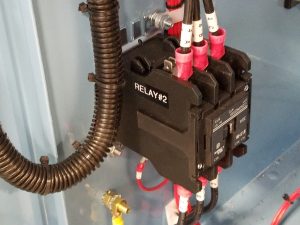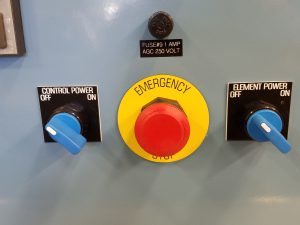
To sign up to receive our emails, fill in the following fields and hit submit. Thanks, and welcome!
"*" indicates required fields

To sign up to receive our emails, fill in the following fields and hit submit. Thanks, and welcome!
"*" indicates required fields

Why won’t my furnace heat?
If your furnace isn’t heating at all, start here:

Contactor

Control and element power switches
You should hear a “clunk”. That’s the contactor (image right) allowing power to the system.
The following troubleshooting instructions apply whether your furnace is not heating at all or lagging behind the setpoint. You need to determine whether or not you have one or more broken elements. This is the most likely and most common cause of such problems.
If your furnace system is designed for single phase power, you might have, for example, just one series of six elements. If your furnace control power and element power are on and you are running a program, you should get a reading on your ammeter indicating that power is going to the elements. If you see all zeroes on the meter, chances are one or more elements in that single series are broken. If one goes out, the circuit is interrupted and no heating occurs.
You might instead have elements in series parallel; that is, two series of elements. In this case if an element goes out in one series, that series will be interrupted but the remaining series – with no broken elements – can and will continue to heat. In this case, the ammeter might have a lower-than-expected reading. For example, you might be accustomed to seeing 20 amps indicated at this particular segment of the program you are running, but this time the reading is ten amps. That could be because one of the two series of elements is out.
If your furnace system is designed to run on three phase power, you will have three series of elements. If one or more elements in one series is out, one of your ammeters might read, for example, 25 amps, while the others read 12 and 13 amps, respectively. Readings may vary because three phase power is somewhat complicated. What’s significant is that they aren’t all reading the same, which they would be if all the elements were intact.
Now it’s time to check for broken elements. While the titles are a bit misleading, the instructions for doing so can be found in our video tutorials entitled, “3-6mm Element Removal Tips” and “6-12mm Element Removal Tips”.

Deltech is a family owned small business incorporated in 1968. Members of the Stevenson family are part of the day-to-day operations in management, sales, engineering, and production.
Address:
Deltech Inc.
1007 East 75th Avenue, Unit E
Denver, CO 80229-6442 U.S.A.
© Copyright 1998 -2024 Deltech Furnaces
PRIVACY POLICY | SITE REQUIREMENTS | SITE MAP | INFO FOR EMPLOYEES
Our ongoing accessibility effort works towards being in line with the Web Content Accessibility Guidelines (WCAG) version 2.2, levels A and AA criteria. These guidelines not only help make web content accessible to users with sensory, cognitive, and mobility disabilities but ultimately to all users, regardless of ability.
This website is just part of a meaningful change in making all State of Colorado services inclusive and accessible. We welcome comments on how to improve this website’s accessibility for users with disabilities and for requests for accommodations to any State of Colorado services.